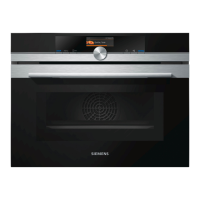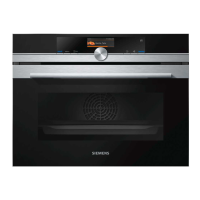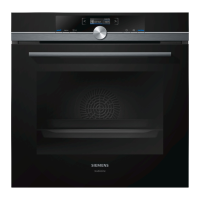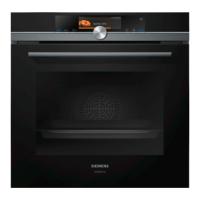en How it works
40
29.7 Special cooking methods and other
applications
Information and recommended settings for special
cooking methods and other applications, e.g. low-tem-
perature cooking.
Low-temperature cooking
For all prime cuts which are to be cooked rare or "à
point". When slow cooking at low temperatures, meat
and poultry remain juicy and tender.
Low-temperature cooking poultry or meat
Note:When using the low-temperature cooking type of
heating, you cannot delay the start of the programme
by setting an end time.
Requirement:The cooking compartment is cold.
1.
Use fresh, hygienically perfect meat. Pieces without
bones and without a lot of connective tissue are
most suitable.
2.
Place the cookware onto the wire rack at level 1 in
the cooking compartment.
3.
Preheat the cooking compartment and cookware for
approx. 15minutes.
4.
Sear the meat on all sides on the hob at a very high
heat.
5.
Immediately place the meat into the pre-warmed
cookware in the cooking compartment.
To ensure that the temperature in the cooking com-
partment remains constant, keep the cooking com-
partment door closed during low-temperature cook-
ing.
Tips for low-temperature cooking
Here you will find tips for achieving good results when
low-temperature cooking food.
Issue Tip
You want to cook a
duck breast at a low
temperature.
¡ Place the cold duck breast
into a pan.
¡ Sear the skin side first.
¡ Cook the duck breast at low
temperature.
¡ After low-temperature cook-
ing, grill the duck breast for
3 to 5minutes until crispy.
You want to serve
your low-temperat-
ure cooked meat as
hot as possible.
¡ Preheat the serving plate.
¡ Make sure that the accom-
panying sauces are very hot
when you serve them.
Recommended settings for low-temperature cooking
Food Accessory/
cookware
Height Searing
time in
mins
Type of
heating
Temperat-
ure in °C
Mi-
crowave
power
setting in
W
Cooking time
in mins
Duck breast, medium
rare, 300g each
Uncovered
cookware
1 6-8 95
1
- 45-60
Fillet of pork, whole Uncovered
cookware
1 4-6 85
1
- 45-70
Fillet of beef, 1kg Uncovered
cookware
1 4-6 85
1
- 90-120
Veal medallions,
4cm thick
Uncovered
cookware
1 4 80
1
- 40-60
Saddle of lamb,
boned, 200g each
Uncovered
cookware
1 4 85
1
- 30-45
1
Preheat the appliance.
Defrosting
You can defrost frozen food in your appliance.
Tips for defrosting food
¡ You can use the "microwave" mode to defrost
frozen fruit, vegetables, poultry, meat, fish or baked
goods.
¡ Remove frozen food from its packaging before you
defrost it.
¡ Use heat-resistant, microwave-safe cookware.
¡ The recommended settings are for freezer-temperat-
ure food (-18°C).
¡ Defrosting works best if you divide it into more than
one step. The steps are listed one after the other in
the recommended settings tables.
¡ Stir or turn the food 1-2times during defrosting.
Turn large items several times. Split the food into
smaller pieces as it defrosts.
Remove pieces that have already defrosted from the
cooking compartment.
¡ Once the food has defrosted, switch off the appli-
ance and leave the food in the appliance for another
10 to 30minutes to allow the temperature to equal-
ise.

